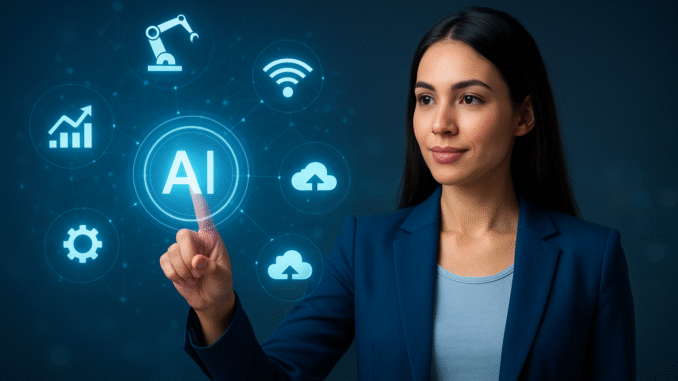
From AI to Automation: Exploring the Smart Technologies Shaping the Future
The 21st century is witnessing a technological revolution unlike any before. From artificial intelligence (AI) and automation to robotics, smart devices, and data-driven systems, innovation is transforming how we live, work, and connect. In 2025 and beyond, these technologies are not only advancing industries but also shaping the very fabric of society.
In this article, we’ll explore how AI, automation, and other smart technologies are redefining modern life, creating smarter cities, empowering businesses, and paving the way for a sustainable and intelligent future.
1. Artificial Intelligence: The Foundation of Smart Innovation
Artificial Intelligence is the heartbeat of today’s technological transformation. Once a futuristic concept, AI is now seamlessly integrated into daily life — from digital assistants and chatbots to medical diagnostics and business analytics.
AI systems learn from massive amounts of data, analyze patterns, and make intelligent predictions or decisions. This capability enables machines to think, learn, and act with increasing autonomy.
In 2025, AI has reached new levels of sophistication:
- Generative AI tools can create text, images, and music, revolutionizing content creation and entertainment.
- Predictive AI helps businesses anticipate customer needs, reduce costs, and increase efficiency.
- AI in healthcare detects diseases early through image recognition and data analysis, improving survival rates.
AI also plays a crucial role in sustainable development. By optimizing energy consumption, managing traffic flow in smart cities, and supporting climate research, AI is making the world smarter — and greener.
But with these advances come responsibilities. Ethical considerations, data privacy, and transparency must guide AI development to ensure it benefits humanity as a whole.
2. Automation: Efficiency Through Intelligence
Automation has long been associated with manufacturing, but in today’s digital age, it touches every sector — from retail and logistics to finance and education. The essence of automation lies in performing repetitive or complex tasks with minimal human intervention, allowing people to focus on creativity, strategy, and problem-solving.
In 2025, automation has evolved into intelligent automation, combining robotic process automation (RPA) with AI. Businesses use it to streamline workflows, enhance customer experience, and reduce operational costs.
For example:
- Retail companies use automated inventory systems to restock shelves in real time.
- Banks deploy AI-driven bots to process transactions and detect fraud instantly.
- Factories employ collaborative robots (cobots) that work alongside humans to increase precision and safety.
Automation is also transforming transportation. Self-driving cars, drones, and smart traffic systems are reducing accidents and congestion, while lowering carbon emissions.
Far from eliminating jobs, automation is reshaping the workforce, creating demand for roles in programming, data analysis, and system design. The key to success lies in reskilling and preparing workers for the jobs of tomorrow.
3. The Internet of Things (IoT): Connecting the World Around Us
The Internet of Things (IoT) refers to a vast network of interconnected devices that collect and share data. From smart home appliances to wearable fitness trackers, IoT has become an integral part of modern life.
In 2025, IoT has evolved into an ecosystem that bridges the gap between the physical and digital worlds. Smart sensors, AI analytics, and cloud computing work together to provide real-time insights and control.
Here’s how IoT is shaping various sectors:
- Smart homes: Lights, thermostats, and security systems adjust automatically based on user preferences.
- Smart cities: IoT devices monitor energy usage, manage waste, and optimize traffic flow for efficiency and safety.
- Healthcare: Wearable devices track vital signs, enabling doctors to monitor patients remotely.
- Agriculture: IoT sensors analyze soil conditions and irrigation levels, ensuring sustainable food production.
With billions of devices online, cybersecurity is critical. Protecting user data and maintaining privacy are top priorities in ensuring that IoT remains a force for good.
4. Robotics: The Hands and Eyes of the Future
Robots are no longer confined to assembly lines. Today, they’re delivering packages, performing surgeries, exploring space, and even assisting in education. The latest generation of robots combines AI, machine learning, and advanced sensors to adapt to dynamic environments and perform complex tasks.
- In healthcare, surgical robots assist doctors in performing minimally invasive procedures.
- In retail, service robots greet customers and restock shelves.
- In disaster response, drones and robotic units perform search-and-rescue operations in hazardous zones.
Robots are also enhancing productivity in industries like logistics and agriculture, where precision and speed are vital. The rise of humanoid robots — machines that mimic human expressions and movements — is redefining human-robot interaction, making technology more approachable and useful.
As robotics continues to advance, ethical questions about autonomy, employment, and social responsibility must be addressed thoughtfully.
5. Data and Analytics: Powering Smart Decision-Making
Behind every smart technology lies data — the digital fuel of the modern world. Data analytics transforms raw information into meaningful insights, helping individuals and organizations make better decisions.
Today’s systems don’t just collect data — they analyze it in real time, enabling instant responses. AI-powered analytics platforms predict customer behavior, detect anomalies, and optimize performance in every industry.
For instance:
- Healthcare analytics helps predict disease outbreaks.
- Retail analytics personalizes shopping experiences.
- Urban analytics supports sustainable city planning.
In 2025, the integration of edge computing — processing data closer to where it’s generated — has improved speed and security, especially for IoT applications. The result is a more efficient, connected, and responsive world.
6. 5G and Beyond: Accelerating the Digital Revolution
Connectivity is the backbone of all modern technologies, and 5G networks have redefined speed, reliability, and capacity. With download speeds up to 100 times faster than 4G, 5G supports seamless communication between billions of connected devices.
This connectivity enables:
- Smart factories where robots communicate in real time.
- Autonomous vehicles that exchange data to avoid collisions.
- Remote surgeries performed through ultra-low-latency networks.
Looking ahead, the next generation — 6G — promises even more revolutionary applications, including holographic communication and enhanced virtual experiences. Faster networks will empower technologies that once seemed like science fiction.
7. Virtual and Augmented Reality: The New Frontier of Experience
Virtual Reality (VR) and Augmented Reality (AR) are changing the way people learn, shop, and interact. By merging physical and digital worlds, they create immersive experiences that are both practical and entertaining.
In 2025:
- Education uses VR classrooms to teach science, history, and art in interactive ways.
- Healthcare employs AR for surgical guidance and patient rehabilitation.
- Retail and real estate use VR to allow customers to explore products or properties virtually.
The rise of the metaverse — a shared virtual environment — is expanding opportunities for social connection, work collaboration, and entertainment. As VR and AR continue to advance, they’re reshaping not just how we see the world, but how we experience it.
8. Sustainable Technology: Building a Greener Future
Technological progress doesn’t have to come at the expense of the environment. In fact, many innovations are designed to combat climate change and promote sustainability.
Green technologies such as renewable energy systems, smart grids, and eco-friendly materials are becoming the norm. Electric vehicles, powered by improved battery storage, are reducing emissions and transforming transportation.
Smart agriculture technologies are helping farmers optimize resources, while AI-driven systems monitor air and water quality. The integration of sustainability into tech design ensures that the future is not only smarter — but also more responsible.
9. The Human Element: Balancing Progress and Ethics
As technology advances, one thing remains clear: humans must remain at the center of innovation. The challenge isn’t just creating smarter machines — it’s ensuring that technology enhances, rather than replaces, human potential.
Ethical frameworks are essential for guiding AI decisions, protecting privacy, and preventing misuse. Transparency, inclusivity, and accountability must shape the future of smart technologies.
Education systems should evolve to prepare the next generation for an AI-driven economy, emphasizing creativity, critical thinking, and adaptability — skills that machines cannot replicate.
Conclusion: The Future Is Now
From AI to automation and beyond, smart technologies are reshaping every aspect of modern life. They promise a future where efficiency, sustainability, and intelligence coexist — transforming how we work, learn, travel, and interact.
Yet, the true power of technology lies not in the machines themselves, but in how humanity chooses to use them. When innovation is guided by ethics and purpose, it becomes a tool for progress, equality, and sustainability.
As we look toward the future, one truth stands out: technology isn’t just shaping the world — it’s shaping who we become.

